ECE Prof. Rick Johnson has signal processors and art historians talking about painting authenticationBy Robert EmroGrowing
up in northwestern Georgia, C. Richard Johnson Jr. never visited an art
museum, heard a classical music concert, or attended serious theater. A
second grader when the Soviets launched Sputnik I and the ensuing space
race, Johnson was channeled into engineering when he exhibited an early
aptitude for math and science. Not until he was a student at Georgia
Tech did he get his first taste of fine art.
He was in Germany with a study-abroad program. His travels took
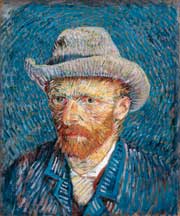 |
Self-Portrait in a Gray Felt Hat: Three Quarters to the Left, September 1887–October 1887. Courtesy The Van Gogh Museum.
-Van Gogh Museum
|
him to the Gemäldegalerie (Picture Gallery) in Berlin. This collection
of old masters was split by the wall when Johnson visited in the early
1970s. Even so, the West German side still held an impressive
collection, including The Man With the Golden Helmet, one of
Rembrandt’s most famous paintings. Seeing it for the first time was a
revelation. “I spent several hours in the Rembrandt rooms,” says
Johnson. “I didn’t know why. I just had some kind of response to it.”
From
a working-class family, Johnson didn’t even entertain the idea that he
could somehow make a career of art. “It never even crossed my mind at
that point,” he says. “That just wasn’t done where I come from.”
But
he couldn’t stay away. As an electrical engineering grad student at
Stanford, Johnson took a course on Rembrandt knowing that if he bombed,
the F would not appear in his record. Far from flunking, he was one of
the star pupils. During one test, he was the only person to realize
that a slide of a Frans Hals painting had been loaded backwards. He
could tell because Hals always painted the light falling from the left.
One class led to another and by the time Johnson graduated in 1977 he
had pioneered Stanford’s first Ph.D. minor in art history. The topic of
his final report, appropriately enough, was Vermeer’s use of the camera
obscura. Careful measurement of the angles in his paintings and
reconstructions of the rooms he painted them in have led some to argue
that Vermeer used this rudimentary optical device in creating his
almost photographic paintings.
“It was a survival technique to
get myself through engineering, to some extent,” says Johnson. “Art
history is something I found a passion for that I see in my students
for technical things that I sometimes don’t have.”
Johnson
received an appointment as an assistant professor at Virginia Tech, but
he was still drawn to art history and after a couple of years he put
together a book proposal on Rembrandt’s self-portraits. He knew he was
at a major fork in the road of his life, and he was willing to take a
different path, but it turned out Kenneth Clark had just written an
about-to-be published chapter on the same topic. His proposed
collaborator’s publisher rejected the proposal.
 |
Lumiere Technology of Paris used its multi-spectral digital camera to capture images of van Gogh’s The Bedroom.
-Lumiere Technology
|
So
Johnson took a position at Cornell instead, joining the faculty as an
associate professor in 1981. He continued a successful academic
engineering career in the School of Electrical and Computer
Engineering, periodically reinventing himself. First he worked on the
theory behind adaptive feedback systems, used to kill the echo you can
sometimes hear while talking on the telephone, then he created and
analyzed blind equalization algorithms, used in receiving hi-def TV.
But he never lost his love of art history, so in 2005, when he was
ready to change his research focus once again, he began wondering how
his expertise in signal processing could get him a backstage museum
pass.
“When I decided to change, I looked for an area where I
would have some special talents,” he says. “I asked myself, ‘How can I
leverage something I know into getting behind the scenes?’”
Johnson
knew that art historians and curators used a variety of technologies to
study paintings, including X-radiography, infra-red photography, and UV
fluorescence. While on a Fulbright in Paris, Johnson arranged a lunch
meeting with Louis van Tilborgh, a curator at the Van Gogh Museum in
Amsterdam. He offered his services as a translator helping the art
history experts at the museum communicate with the technical types
doing the image processing. Tilborgh was intrigued and asked Johnson to
make a more formal presentation to museum management. While preparing,
Johnson discovered that these tools helped de-attribute the very
painting that awakened his passion for art in the first place. In 1985,
the Rembrandt Research Project determined The Man with the Golden
Helmet was not painted by Rembrandt but by an unnamed apprentice.
The
museum liked the idea of having an expert in signal processing to help
connect them with the computer-based technology used in painting
authentication and gave Johnson a five-year appointment as an adjunct
research fellow. “I’m a Ph.D. student again, working for the head of
conservation at the Van Gogh Museum, doing with her what she does and
finding out what we can give to a computer to do—which is mostly signal
processing,” he says. “Whether the data comes from a CAT scan or a
satellite or a painting, it becomes an array of numbers to which the
kit of signal processing tools can be applied.”
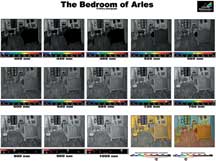
|
The Bedroom in 13 spectra, from ultra-violet to infrared, plus false color infrared and visible light.
-Lumiere Technology
|
“It’s quite a luxury for me to have a student that’s so efficient and
hardly needs any supervision. He’s so enthusiastic,” says Ella
Hendriks, Johnson’s new adviser. “He’s willing to spend time for things
that are hugely useful.”
While some in the art world balk at the
idea that a computer can perform the duties of a human art expert, the
Van Gogh Museum has embraced this new technology. “It’s not replacing
the judgment of the art historian, it’s simply an added tool that will
assist the art historian in making his judgment,” says Hendriks. “It’s
very important to make a good tool and the best way to do that is to
collaborate with the tool maker. If you’re involved at the beginning
you’re going to get the best tool.”
One thing Johnson has done
in his new role is connect the museum with a company in Paris—Lumiere
Technology—that has designed a multi-spectral camera for digitizing
works of art. The company used it to reveal the true colors of the Mona
Lisa in 2004. He helped convince Lumiere and the Van Gogh Museum to
take images of The Bedroom and The Potato Eaters in October. If all
goes well, the company will do the rest of the museum’s collection,
amassing a huge database for engineers and art historians to work with.
“It’s just been a dream to me because all the doors seemed to open up
for the asking,” says Johnson.
In a year or so, Johnson
envisions teaching a new course at Cornell examining how others have
approached using signal processing to authenticate art so students can
infer a general approach to the problem. He hopes his interaction with
the museum will eventually result in a textbook that combines art
history with technical material. “I’m not an engineering professor just
because I want to tinker with cool things,” he says. “I’m an academic
because I want to teach cool things.”
But first Johnson wants to
bring together the scattered groups working at this intersection of
engineering and fine art. “This is a field that doesn’t really exist
yet,” he says. “There are some people out there doing things, but not
as a cohesive field.”
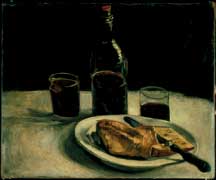
|
Once considered a Van Gogh, Still Life with Bottle of Wine, Two Glasses, and Plate with Bread and Cheese is now thought to be by an unknown friend of Vincent’s brother Theo.
-Van Gogh Museum
|
Dan
Rockmore, a professor of math and computer science at Dartmouth, has
been working with the Metropolitan Museum of Art in New York to
authenticate Rembrandts. Professors Jia Lee and James Wang at Penn
State have identified the creators of Chinese ink paintings from the
15th to 20th centuries. And researchers led by Eric Postma at the
University of Maastricht in the Netherlands have developed a program
dubbed “Authentic” that can distinguish between the works of Van Gogh,
Cézanne, and Gaugin. Although they all use a variation of a technique
called stylometry, first developed to identify literary authors, they
had never met as a group to share ideas.
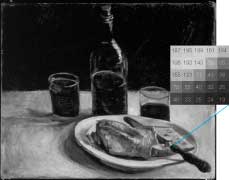
|
Working
with the gray scale values of each pixel in a digital image of the
painting, signal processors at the workshop were able to use wavelet
processing to corroborate the connoisseur’s determination.
-Van Gogh Museum
|
The
field is set to flourish. Research on how to best collect and organize
data from paintings is mature and recent technological advances have
enabled museums to amass huge databases of images. “The time is
certainly right in that people have been thinking about images
computationally for a long time. It certainly makes sense as a science
problem to compare images and see if you can find some commonality,”
says Rockmore. “The problem’s a totally natural one. Whether it has a
nice solution is one that everyone is working on. There are a lot of
aspects there and you only discover them when you drill down and treat
it as a science.”
Beyond determining if a painting is really by
a master, or just a clever forgery, forensic signal processing can help
art historians determine the sequence of an artist’s work, or
deconstruct a painter’s process by identifying which strokes went on
first. “There’s a lot of things I think [curators] can think of that
would be impossible, but there’s a lot of things we should be able to
do,” says Johnson. “Any time the art historian looks at the image for
the information they need, we should be able to help.”
To get
signal processors and art curators together, Johnson organized the
First International Workshop on Image Processing for Artist
Identification, held at the Van Gogh Museum May 14. Johnson convinced
the Van Gogh Museum and the Kröller-Müller Museum in Otterlo,
Netherlands, to make digitized images of 101 of their paintings
available for analysis. Most are confirmed Van Goghs, but a few are now
attributed to others. This irresistible “goldmine” of data got several
groups of academic signal processors on board. To get them talking with
the attendees from museums across Europe, the daylong program
introduced curators to the capabilities of signal processing and
engineers to the techniques of connoisseurship, the traditional method
of authenticating paintings. Johnson’s unique background helped him get
the conversation rolling. “He knows both sides of the story, which is
needed,” says Hendriks. “He knows the words we use to talk about
things.”
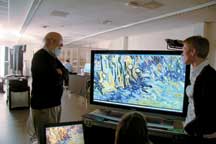 |
ECE
Prof. Rick Johnson and Van Gogh Museum Head of Conservation Ella
Hendriks observe a false color infrared digital image of Van Gogh’s Tree Trunks in the Grass captured by Lumiere Technology’s multi-spectral camera.
-Lumiere Technology
|
Six
months before the workshop, three teams of computer scientists,
mathematicians, electrical engineers, and statisticians from Penn
State, Princeton, and Maastricht universities set about to see if
mathematical analysis could find similarities in Van Gogh’s works not
present in the other paintings. They also checked the authentic
paintings against a 102nd, a modern copy of a Van Gogh commissioned by
WGBH’s Nova Science Now. The program taped the researchers at the
workshop and is scheduled to air on PBS nationally beginning next June.
All
three teams were successful to some degree at distinguishing real Van
Goghs from the copies. The Princeton team found a higher concentration
of high spatial frequency content, corresponding to an increased number
of small touches in the copies. This jibes with the commonly noted
tendency of copyists to use several small brush strokes to duplicate an
image that the original artist may have done in one stroke.
Even
more importantly, workshop participants expressed a desire for further
interaction. A repeat workshop was held Nov. 9 at the Museum of Modern
Art in New York City. Already, art historians and engineers around the
world are planning new projects based on the resulting
cross-fertilization. “The idea is to amplify this whole thing,” says
Johnson. “I’m sure there are signal processing research problems in
this area that people don’t yet know exist, and you can trip over them
a bunch of times without noticing them.”
A next step to building
a cohesive field, says Johnson, is to present problems to beginning
engineers so they can start thinking of creative new approaches to
solving them, just as in any other field of engineering. So Johnson has
been recruiting undergrads and M.Eng. students to work on an automated
thread-count project.
Yeounoh Chung got involved because it
was a little different from other projects he has worked on. “It seemed
like a really interesting project because it has to do with art,” says
the senior. “As an ECE student, all I’ve been doing is making something
that people don’t usually see, but this is more directly related to
something people can see and appreciate, so I thought it could be
something I could enjoy doing.”
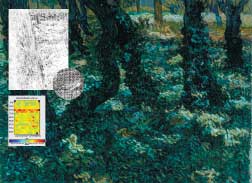 |
Using
high-resolution digital images of x-rays, the automated thread count
method under development by Johnson and a team of students reveals a
strip (in red) of more tightly woven canvas in a corner of Van Gogh’s
Undergrowth. Such patterns can help art historians better sequence an
artist’s work or art curators restore paintings that have been cut into
pieces.
-Van Gogh Museum/Rick Johnson
|
Knowing
how many threads are in a canvas can reveal a lot to an art historian.
Thread counts of the canvases used by Van Gogh and Gauguin during their
time together at the Yellow House in Arles, France, in late 1888 helped
art historians to construct a timeline for the paintings during this
important period. Traditionally, thread counts are estimated using an
average of the number of threads hand-counted in five different
2-square-centimeter sections. It’s a tedious, time-consuming process
and museums would much rather allocate staff time to other work. A
computer could do it a lot faster, says Johnson, and by looking at more
samples, more thoroughly. Unlike typical hand counts, a computer count
is readily repeatable because it can keep an exact record of where it
has counted.
Technology alone won’t provide all the answers,
however. Without knowing that Van Gogh sometimes painted on canvas from
a limited number of bolts, thread counts would not have revealed much.
“It depends on the artist’s practice,” says Johnson. “So it’s a mixture
of knowing what they did and relating the physical evidence to that.”
The
project illustrates some of the differences in mind-set among
engineers, curators, and conservators. When Johnson first started
working on an automated thread-count program, he asked to see the
reference book that explains how art historians do such procedures and
was told there was no such book. Variations of the process are passed
verbally from expert to student. “But this can be broken down into an
ordered series of steps. We engineers see this because we’re taught to
do this in everything we do,” says Johnson. “Once we know the steps, we
can see where we can help. So, even in this unusual application, we’re
going to act like regular engineers and come into somebody else’s
application and use our skills to make their life better.”
